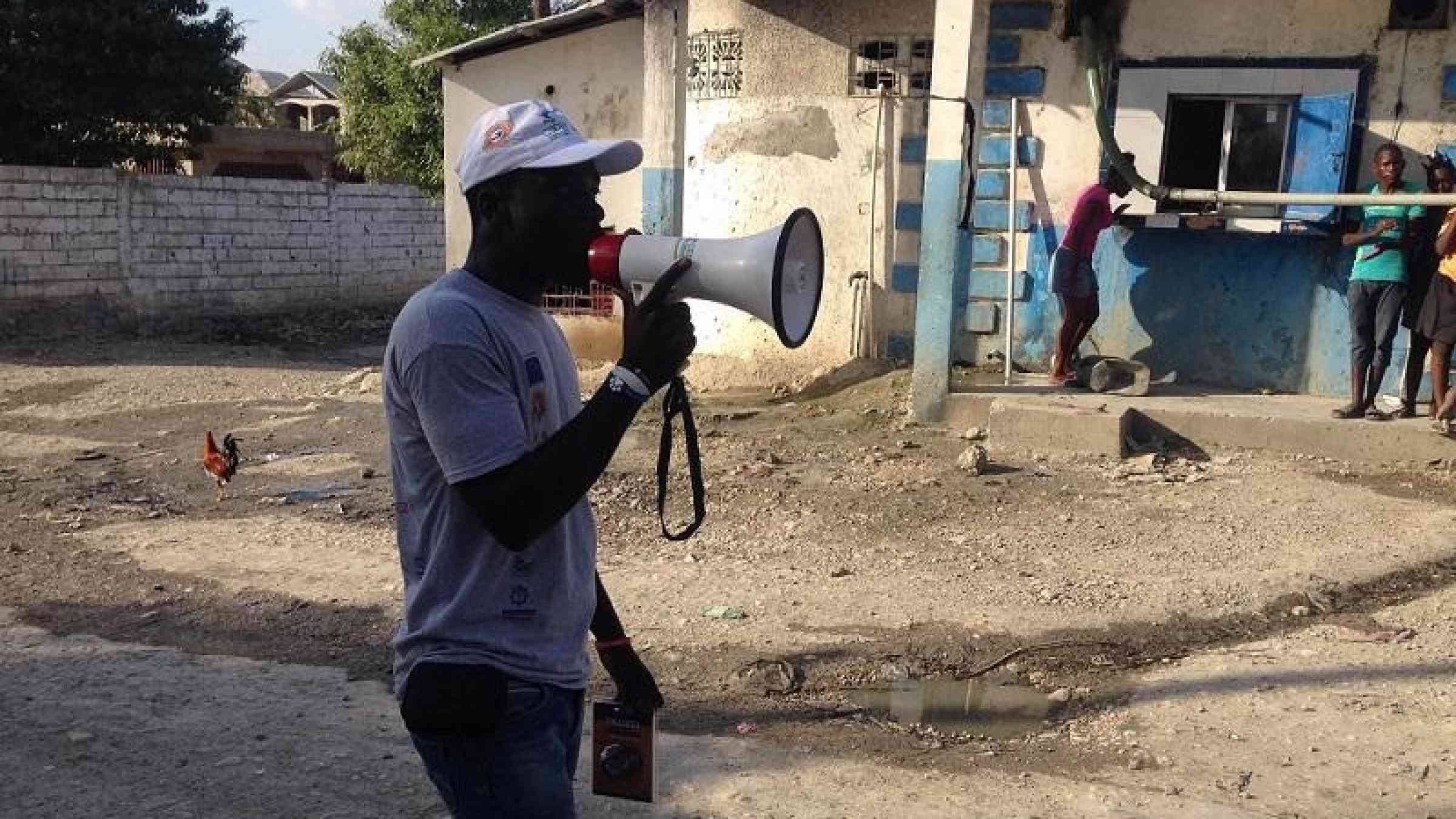Haiti: evacuation drills in urban communities

By Mercedes Aguerre
The sun begins to set in Village Gari, Saint Philomene, Tabarre Municipality of Port-au-Prince. Children enjoy the last minutes of light before night falls. Not too far away, the Grise River flows by. On several occasions, this river has caused large floods due to heavy rainstorms. Ms. Molina Orizar lives just beside the river. While grinding some coffee, she tells us that during Hurricane Sandy in 2012, the swollen river swept alongside her house. She and her family had to move to a friend’s house for a year thereafter. Afterwards, she was relocated to another risk zone because she did not have the necessary financial means to find a less vulnerable place.
Suddenly, the population begins to mobilize following a warning from the Communal Intervention Units. The following message is clearly audible: “We are currently on orange alert. Be attentive. Prepare for a possible evacuation and be sure to take your Family Emergency Kits.” People begin to look at each other, knowing that something is about to happen. They immediately return to their houses to prepare their families in case of evacuation. These are the instructions the community has received from the Communal Intervention Units of Saint Philomene during the last week, in which the units carried out awareness sessions and prepared the population for the evacuation drill.
In the framework of the DIPECHO project, “Capacity reinforcement for the preparation, mitigation and response to disasters for the most vulnerable urban communities in Haiti,” financed by the European Commission’s Humanitarian Aid and Civil Protection Department (ECHO), the Departmental Disaster Risk Management Committee and COOP have developed a methodology to implement multi-hazard evacuation drills at the urban community level. Today’s scenario is a landslide, a hazard that represents a risk in Saint Philomene. In 2012, the community fell victim to this particular hazard due to heavy rainstorms that took place during the hurricane season. Fortunately, there were no human casualties, but community members were shocked by the destructive force of the event.
At 5:10 p.m., the Civil Protection Local Committee announces a red alert level to the Head of the Communal Intervention Units of Saint Philomene. In the disaster scenario planned for the evacuation drill, the weather conditions have just worsened. It is therefore essential to proceed with an evacuation. The Haitian Red Cross and the Scouts have been alerted, as the evacuation drill will be carried out through the joint efforts of the local stakeholders present in the area. When a disaster hits, all organized local stakeholders in the zone must be prepared to provide support to the local population.
The moment has arrived. At 5:30 p.m. the siren is activated and we hear the whistles of the Communitarian Intervention Units blow. The alert has been given. “Attention population! The evacuation has begun! Grab your Family Emergency Kits, hold your children by the hand and start evacuating.”
A population of around 120 people begins to evacuate. The evacuation route is indicated by the presence of the Civil Protection members and the Scouts, who are present at every corner and every crossroad. Some women carry their Family Emergency Kits over their heads. The children, curious, watch everything that is happening around them while their mothers hold them tightly by their sides. One person complains, enacting the role of a victim who is hurt and walking with difficulty. She is escorted by a Scout who helps her walk. A red tag hangs from her neck, indicating that she has a serious wound at her knee level. The Communitarian Intervention Units have done a triage process to determine the priority-level of wounded victims based on the severity of their condition. Those with a red tag will be given priority when first aid is given.
The population begins to arrive at the assembly point, indicated at the end of the evacuation route. A circle begins to form with persons carrying t-shirts of varying colors. These represent diverse local stakeholders: orange for Civil Protection, brown for the Scouts, yellow for the Communitarian Intervention Units and red for the Haitian Red Cross. Inside the circle, the victims lay down and the Red Cross administers first aid. The Communitarian Intervention Units use this moment to explain to the participants the dangers they face in living in this area and the importance of being well prepared.
As night begins to fall, the Communitarian Intervention Units turn on their head torches to illuminate the scene. Finally, a member of the Civil Protection Communal Committee approaches the Civil Protection Local Committee to signal the end of the alert. According to the scenario, the Departmental Disaster Risk Management Committee instructed him to end the alert and to notify the participants via the Communitarian Intervention Units.
People begin to disperse. The impact of the evacuation drill is already apparent: participants share enthusiastic comments and photos of the events just experienced.